High-Quality Bioethanol and Vinegar Production from Saudi Arabia Dates: Characterization and Evaluation of Their Value and Antioxidant Efficiency
Abstract
:1. Introduction
2. Materials and Methods
2.1. Raw Materials
2.2. Sugar Extraction
2.3. Microorganisms and Growth Medium
2.4. Preparation of the Fermentation Medium
2.5. Alcoholic Fermentation Test
2.6. Acetic Fermentation
2.7. Chemicals
2.8. Analysis
2.9. Antioxidant Activity of the Produced Date Vinegar
2.9.1. Total Phenolic Content Determination
2.9.2. DPPH (1,1-Diphenyl-2-picrylhydrazyl) Radical Scavenging Activity
2.9.3. FRAP Assay
2.9.4. Total Carotenoid Contents
2.10. Statistical Analysis
3. Results
3.1. Sugar Extraction and Evolution of Total Soluble Solids
3.2. Bioethanol Production
3.3. Infrared Spectroscopy Analysis
3.4. Vinegar Production
3.5. IR Analysis
3.6. H NMR Analysis
3.7. In Vitro Antioxidant Activity
3.7.1. Total Phenolic Content Assay
3.7.2. Radical DPPH Scavenging Activity
3.7.3. Ferric Reducing Antioxidant Potential
3.7.4. Total Carotenoid Content
4. Conclusions
Future Perspective and Economic Assessment
Author Contributions
Funding
Institutional Review Board Statement
Informed Consent Statement
Data Availability Statement
Conflicts of Interest
References
- Chao, C.C.T.; Krueger, R.R. The date palm (Phoenix dactylifera L.): Overview of biology, uses, and cultivation. HortScience 2007, 42, 1077–1082. [Google Scholar] [CrossRef] [Green Version]
- NationMaster.com. Available online: https://www.nationmaster.com/nmx/ranking/dates-production (accessed on 19 March 2022).
- Borchani, C.; Besbes, S.; Blecker, C.; Masmoudi, M.; Baati, R.; Attia, H. Chemical properties of 11 date cultivars and their corresponding fiber extracts. Afr. J. Biotechnol. 2010, 9, 4096–4105. [Google Scholar]
- Al-Farsi, M.; Lee, C.Y. Nutritional and functional properties of dates. Crit. Rev. Food Sci. Nutr. 2008, 48, 877–887. [Google Scholar] [CrossRef]
- Bkary, M.A.; Metwaly, A.-E.-R.; Syed, M.; Sayed Ghazzawy, H. Use of rejects of date palm factories to bakery yeast production. Int. J. Biosci. 2018, 6655, 269–274. [Google Scholar]
- Sharma, B.; Larroche, C.; Dussap, C.G. Comprehensive assessment of 2G bioethanol production. Bioresour. Technol. 2020, 313, 123630. [Google Scholar] [CrossRef]
- Vasic, K.; Knez, Z.; Leitgeb, M. Bioethanol Production by Enzymatic Hydrolysis from Different. Molecules 2021, 26, 753. [Google Scholar] [CrossRef]
- Permatasari, N.S.; Zainuri, M.; Kusumaningrum, H.P.; Mishbach, I.; Hastuti, E.D. Bioethanol production using the SSF method (simultaneous saccharification and fermentation) of microalgae anabaena sp. J. Phys. Conf. Ser. 2020, 1524, 012071. [Google Scholar] [CrossRef]
- Alamri, S.A.; Hashem, M.; Alrumman, S.A.; Al-Qahtani, M.S.A. Enhancement of bio-ethanol production from date molasses by non-conventional yeasts. Res. J. Microbiol. 2015, 10, 114–125. [Google Scholar]
- Chniti, S.; Djelal, H.; Hassouna, M.; Amrane, A. Residue of dates from the food industry as a new cheap feedstock for ethanol production. Biomass Bioenergy 2014, 69, 66–70. [Google Scholar] [CrossRef]
- Ghanim, A.N. Bioethanol Production from Iraqi Date Palm Resources. J. Univ. Babylon Eng. Sci. 2013, 21, 239–248. [Google Scholar]
- Bassam, R.A.L.; Emirates Dates Factory-AI Saad, AI Ain, United Arab Emirates. Industrial Ethanol Production Using Juice of Dates in a Fixed Cell Process. Personal communication, 2001. [Google Scholar]
- Ali, Z.; Ma, H.; Ayim, I.; Wali, A. Efficacy of new beverage made of dates vinegar and garlic juice in improving serum lipid profile parameters and inflammatory biomarkers of mildly hyperlipidemic adults: A double-blinded, randomized, placebo-controlled study. J. Food Biochem. 2018, 42, e12545. [Google Scholar] [CrossRef]
- Chou, C.H.; Liu, C.W.; Yang, D.J.; Wu, Y.H.S.; Chen, Y.C. Amino acid, mineral, and polyphenolic profiles of black vinegar, and its lipid lowering and antioxidant effects in vivo. Food Chem. 2015, 168, 63–69. [Google Scholar] [CrossRef] [PubMed]
- Ali, Z.; Ma, H.; Rashid, M.T.; Wali, A.; Younas, S. Preliminary study to evaluate the phytochemicals and physiochemical properties in red and black date’s vinegar. Food Sci. Nutr. 2019, 7, 1976–1985. [Google Scholar] [CrossRef]
- Ali, Z.; Ma, H.; Wali, A.; Ayim, I.; Sharif, M.N. Daily date vinegar consumption improves hyperlipidemia, β-carotenoid and inflammatory biomarkers in mildly hypercholesterolemic adults. J. Herb. Med. 2019, 17, 100265. [Google Scholar] [CrossRef]
- Juhel, C.; Armand, M.; Pafumi, Y.; Rosier, C.; Vandermander, J.; Lairon, D. Green tea extract (AR25®) inhibits lipolysis of triglycerides in gastric and duodenal medium in vitro. J. Nutr. Biochem. 2000, 11, 45–51. [Google Scholar] [CrossRef]
- Wilcox, L.J.; Borradaile, N.M.; De Dreu, L.E.; Huff, M.W. Secretion of hepatocyte apoB is inhibited by the flavonoids, naringenin and hesperetin, via reduced activity and expression of ACAT2 and MTP. J. Lipid Res. 2001, 42, 725–734. [Google Scholar] [CrossRef]
- Mohd Azhar, S.H.; Abdulla, R.; Jambo, S.A.; Marbawi, H.; Gansau, J.A.; Mohd Faik, A.A.; Rodrigues, K.F. Yeasts in sustainable bioethanol production: A review. Biochem. Biophys. Rep. 2017, 10, 52–61. [Google Scholar] [CrossRef]
- Laffort.com. Available online: https://laffort.com/wp-content/uploads/Table_Convertisseur_v2.pdf (accessed on 9 January 2022).
- Matloob, M.H. Zahdi date vinegar: Production and characterization. Am. J. Food Technol. 2014, 9, 231–245. [Google Scholar] [CrossRef] [Green Version]
- Lapa, R.A.S.; Lima, J.L.F.C.; Pérez-Olmos, R.; Ruiz, M.P. Simultaneous automatic potentiometric determination of acidity, chloride and fluoride in vinegar. Food Control 1995, 6, 155–159. [Google Scholar] [CrossRef]
- Kadiroğlu, P. FTIR Spectroscopy for Prediction of Quality Parameters and Antimicrobial Activity of Commercial Vinegars with Chemometrics. J. Sci. Food. Agric. 2018, 98, 4121–4127. [Google Scholar] [CrossRef]
- Singleton, V.L.; Orthofer, R.; Lamuela-Raventós, R.M. Analysis of total phenols and other oxidation substrates and antioxidants by means of folin-ciocalteu reagent. Meth. Enzymol. 1999, 299, 152–178. [Google Scholar]
- Chen, C.W.; Ho, C.T. Antioxidant properties of polyphenols extracted from green and black teas. J. Food Lipids 1995, 2, 35–46. [Google Scholar] [CrossRef]
- Szollosi, R.; Varga, I.S.I. Total antioxidant power in some species of Labiatae: Adaptation of FRAP method. Acta Biol. Szeged. 2002, 46, 125–127. [Google Scholar]
- Sanusi, R.A.; Adebiyi, A.E. Beta carotene content of commonly consumed foods and soups in Nigeria. Pak. J. Nutr. 2009, 8, 1512–1516. [Google Scholar]
- Prasad, K.N.; Yang, B.; Shi, J.; Yu, C.; Zhao, M.; Xue, S.; Jiang, Y. Enhanced antioxidant and antityrosinase activities of longan fruit pericarp by ultra-high-pressure-assisted extraction. J. Pharm. Biomed. 2010, 51, 471–477. [Google Scholar] [CrossRef]
- Xi, J.; Shen, D.; Li, Y.; Zhang, R. Ultrahigh pressure extraction as a tool to improve the antioxidant activities of green tea extracts. Food Res. Int. 2011, 44, 2783–2787. [Google Scholar] [CrossRef]
- Corrales, M.; Toepfl, S.; Butz, P.; Knorr, D.; Tauscher, B. Extraction of anthocyanins from grape by-products assisted by ultrasonics, high hydrostatic pressure or pulsed electric fields: A comparison. Innov. Food Sci. Emerg. Technol. 2008, 9, 85–91. [Google Scholar] [CrossRef]
- Kaufmann, B.; Christen, P.; Veuthey, J.L. Parameters affecting microwave-assisted extraction of withanolides. Phytochem. Anal. 2001, 12, 327–331. [Google Scholar] [CrossRef]
- Teo, C.C.; Tan, S.N.; Yong, J.W.H.; Hew, C.S.; Ong, E.S. Validation of green-solvent extraction combined with chromatographic chemical fingerprint to evaluate quality of Stevia rebaudiana Bertoni. J. Sep. Sci. 2009, 32, 613–622. [Google Scholar] [CrossRef]
- Louhichi, B.; Belgaib, J.; Benamor, H.; Hajji, N. Production of bio-ethanol from three varieties of dates. Renew. Energy 2013, 51, 170–174. [Google Scholar] [CrossRef]
- Ahmad, A.; Naqvi, S.A.; Jaskani, M.J.; Waseem, M.; Ali, E.; Khan, I.A.; Faisal Manzoor, M.; Siddeeg, A.; Aadil, R.M. Efficient utilization of date palm waste for the bioethanol production through Saccharomyces cerevisiae strain. Food Sci. Nutr. 2021, 9, 2066–2074. [Google Scholar] [CrossRef] [PubMed]
- Ahmed, B.; Mabrouk, K.; Cherif, K.; Boudjemaa, B. Bioethanol production from date palm fruit waste fermentation using solar energy. Afr. J. Biotechnol. 2016, 15, 1621–1627. [Google Scholar] [CrossRef] [Green Version]
- Tesfaw, A.; Assefa, F. Current Trends in Bioethanol Production by Saccharomyces cerevisiae: Substrate, Inhibitor Reduction, Growth Variables, Coculture, and Immobilization. Int. Sch. Res. Notices 2014, 2014, 532852. [Google Scholar] [CrossRef] [Green Version]
- Shafiei, M.; Karimi, K.; Taherzadeh, M.J. Palm date fibers: Analysis and enzymatic hydrolysis. Int. J. Mol. Sci. 2010, 11, 4285–4296. [Google Scholar] [CrossRef] [PubMed] [Green Version]
- Zeinelabdeen, M.A.; Abasaeed, A.E.; Gaily, M.H.; Sulieman, A.K.; Putra, M.D. Coproduction of Fructose and Ethanol from Dates by S. cerevisiae ATCC 36859. Int. J. Chem. Mol. Eng. 2013, 7, 758–761. [Google Scholar]
- Manzoor, M.F.; Zeng, X.A.; Rahaman, A.; Siddeeg, A.; Aadil, R.M.; Ahmed, Z.; Li, J.; Niu, D. Combined impact of pulsed electric field and ultrasound on bioactive compounds and FT-IR analysis of almond extract. J. Food Sci. Technol. 2019, 56, 2355–2364. [Google Scholar] [CrossRef]
- Gerothanassis, I.P.; Troganis, A.; Exarchou, V.; Barbarossou, K. Nuclear Magnetic Resonance (Nmr) Spectroscopy: Basic Principles and Phenomena, and Their Applications to Chemistry, Biology and Medicine. Chem. Educ. Res. Pract. 2002, 3, 229–252. [Google Scholar] [CrossRef] [Green Version]
- Zuriarrain, A.; Zuriarrain, J.; Villar, M.; Berregi, I. Quantitative determination of ethanol in cider by 1H NMR spectrometry. Food Control 2015, 50, 758–762. [Google Scholar] [CrossRef]
- Siddeeg, A.; Zeng, X.A.; Rahaman, A.; Manzoor, M.F.; Ahmed, Z.; Ammar, A.F. Quality characteristics of the processed dates vinegar under influence of ultrasound and pulsed electric field treatments. J. Food Sci. Technol. 2019, 56, 4380–4389. [Google Scholar] [CrossRef]
- Akarca, G.; Tomar, O.; Çaglar, A.; İstek, Ö. İran Mazafati Hurmasından (Phoenix dactylifera L.) Geleneksel Yöntemle Üretilen Sirkenin Fizikokimyasal ve Duyusal Kalite Özellikleri. Eur. J. Eng. Sci. Tech. 2020, 19, 429–434. [Google Scholar] [CrossRef]
- law.justia.com. Available online: https://law.justia.com/codes/rhode-island/2014/title-21/chapter-21-22/section-21-22-2/ (accessed on 1 April 2022).
- Domínguez-Martínez, I.; Meza-Márquez, O.G.; Osorio-Revilla, G.; Proal-Nájera, J.; Gallardo-Velázquez, T. Determination of capsaicin, ascorbic acid, total phenolic compounds and antioxidant activity of Capsicum annuum L. var. serrano by mid infrared spectroscopy (Mid-FTIR) and chemometric analysis. J. Korean Soc. Appl. Biol. Chem. 2014, 57, 133–142. [Google Scholar] [CrossRef]
- Ríos-Reina, R.; Callejón, R.M.; Oliver-Pozo, C.; Amigo, J.M.; García-González, D.L. ATR-FTIR as a potential tool for controlling high quality vinegar categories. Food Control 2017, 78, 230–237. [Google Scholar] [CrossRef]
- Murugesh, S.; Vino, P. Phytochemical Constituents, Antioxidant Activity and FT-IR Analysis of Pisonia grandis Leaf Extracts. Int. J. Pharmacogn. Phytochem. Res. 2018, 9, 933–938. [Google Scholar]
- Sinanoglou, V.J.; Zoumpoulakis, P.; Fotakis, C.; Kalogeropoulos, N.; Sakellari, A.; Karavoltsos, S.; Strati, I.F. On the Characterization and Correlation of Compositional, Antioxidant and Colour Profile of Common and Balsamic Vinegar. Antioxidants 2018, 7, 139. [Google Scholar] [CrossRef] [PubMed] [Green Version]
- Verzelloni, E.; Tagliazucchi, D.; Conte, A. Relationship between the antioxidant properties and the phenolic and flavonoid content in traditional balsamic vinegar. Food Chem. 2007, 105, 564–571. [Google Scholar] [CrossRef]
- Zhu, H.; Zhu, J.; Wang, L.; Li, Z. Development of aanSPME-GC-MS method for the determination of volatile compounds in Shanxi aged vinegar and its analytical characterization by aroma wheel. J. Food Sci. Technol. 2016, 53, 171–183. [Google Scholar] [CrossRef] [PubMed] [Green Version]
- Caligiani, A.; Acquotti, D.; Palla, G.; Bocchi, V. Identification and quantification of the main organic components of vinegars by high resolution 1H NMR spectroscopy. Anal. Chim. Acta 2007, 585, 110–119. [Google Scholar] [CrossRef]
- Moing, A.; Maucourt, M.; Renaud, C.; Gaudillère, M.; Brouquisse, R.; Lebouteiller, B.; Gousset-Dupont, A.; Vidal, J.; Granot, D.; Denoyes-Rothan, B.; et al. Quantitative metabolic profiling by 1-dimensional 1H-NMR analyses: Application to plant genetics and functional genomics. Funct. Plant Biol. 2004, 31, 889–902. [Google Scholar] [CrossRef]
- Aru, V.; Sørensen, K.M.; Khakimov, B.; Toldam-Andersen, T.B.; Engelsen, S.B. Cool-climate red wines—Chemical composition and comparison of two protocols for 1H–NMR Analysis. Molecules 2018, 23, 160. [Google Scholar] [CrossRef] [Green Version]
- Kahkonen, M.P.; Hopia, A.I.; Vuorela, H.J.; Rauha, J.P.; Pihlaja, K.; Kujala, T.S.; Heinonen, M. Antioxidant activity of plant extracts containing phenolic compounds. J. Agric. Food Chem. 1999, 47, 3954–3962. [Google Scholar] [CrossRef]
- Shahidi, F.; Naczk, M. Phenolics in Food and Nutraceuticals, 2nd ed.; CRC Press Taylor & Francis Group: Boca Raton, FL, USA, 2003; p. 576. [Google Scholar]
- Hafzan, Y.; Saw, J.W.; Fadzilah, I. Physicochemical properties, total phenolic content, and antioxidant capacity of homemade and commercial date (Phoenix dactylifera L.) vinegar. Int. Food Res. J. 2017, 24, 2557–2562. [Google Scholar]
- Wu, X.; Beecher, G.R.; Holden, J.M.; Haytowitz, D.B.; Gebhardt, S.E.; Prior, R.L. Lipophilic and hydrophilic antioxidant capacities of common foods in the United States. J. Agric. Food Chem. 2004, 52, 4026–4037. [Google Scholar] [CrossRef]
- Saafi, E.B.; El Arem, A.; Issaoui, M.; Hammami, M.; Achour, L. Phenolic content and antioxidant activity of four date palm (Phoenix dactylifera L.) fruit varieties grown in Tunisia. Int. J. Food Sci. 2009, 44, 2314–2319. [Google Scholar] [CrossRef]
- Al-Farsi, M.; Alasalvar, C.; Morris, A.; Baron, M.; Shahidi, F. Comparison of antioxidant activity, anthocyanins, carotenoids, and phenolics of three native fresh and sun-dried date (Phoenix dactylifera L.) varieties grown in Oman. J. Agric. Food Chem. 2005, 53, 7592–7599. [Google Scholar] [CrossRef] [PubMed]
- Hong, Y.J.; Tomas-Barberan, F.; Kader, A.A.; Mitchell, A.E. The flavonoid glycosides and procyanidin composition of Deglet Noor dates (Phoenix dactylifera). J. Agric. Food Chem. 2006, 54, 2405–2411. [Google Scholar] [CrossRef] [PubMed]
- Meléndez-Martínez, A.J.; Britton, G.; Vicario, I.M.; Heredia, F.J. Relationship between the colour and the chemical structure of carotenoid pigments. Food Chem. 2007, 101, 1145–1150. [Google Scholar] [CrossRef]
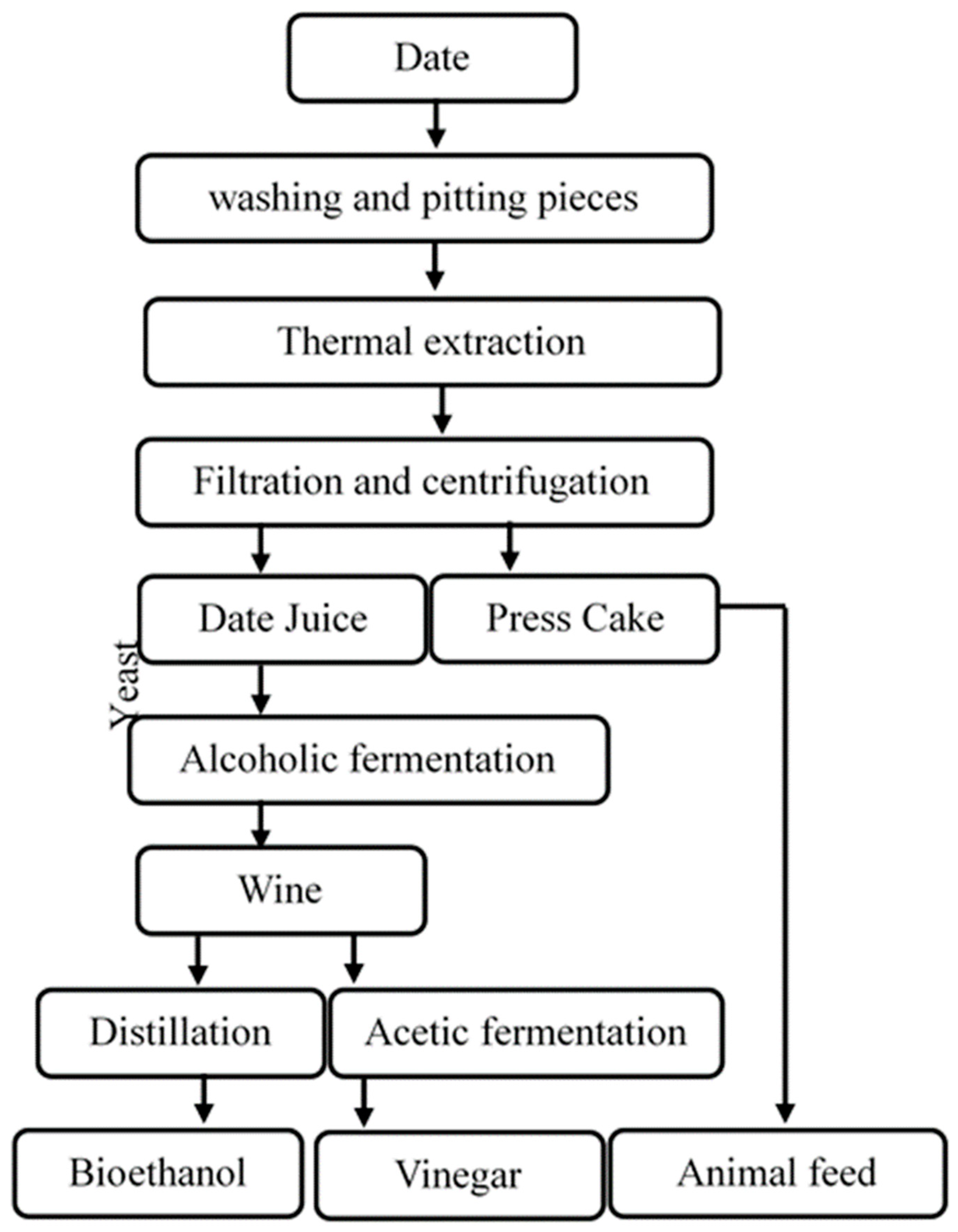
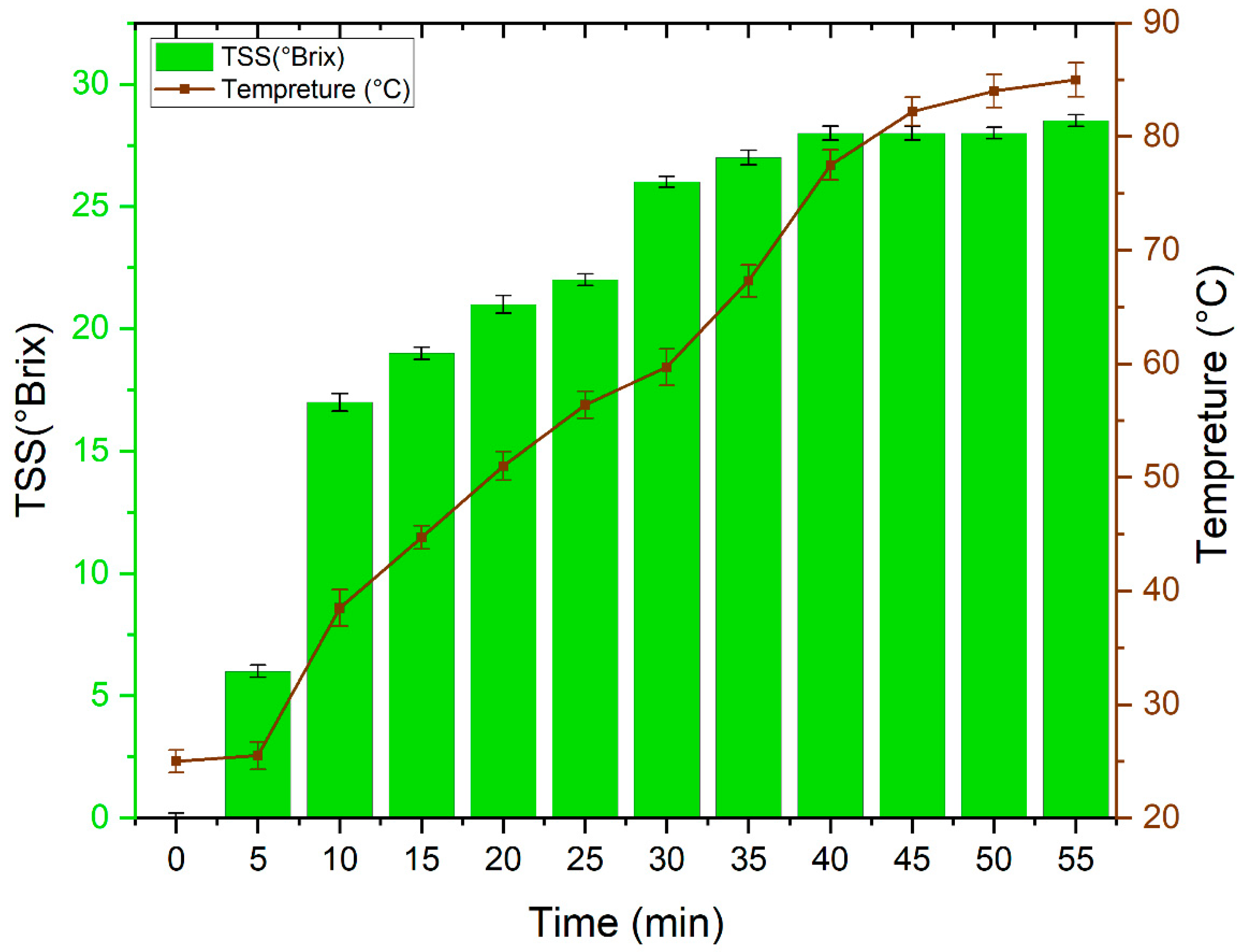
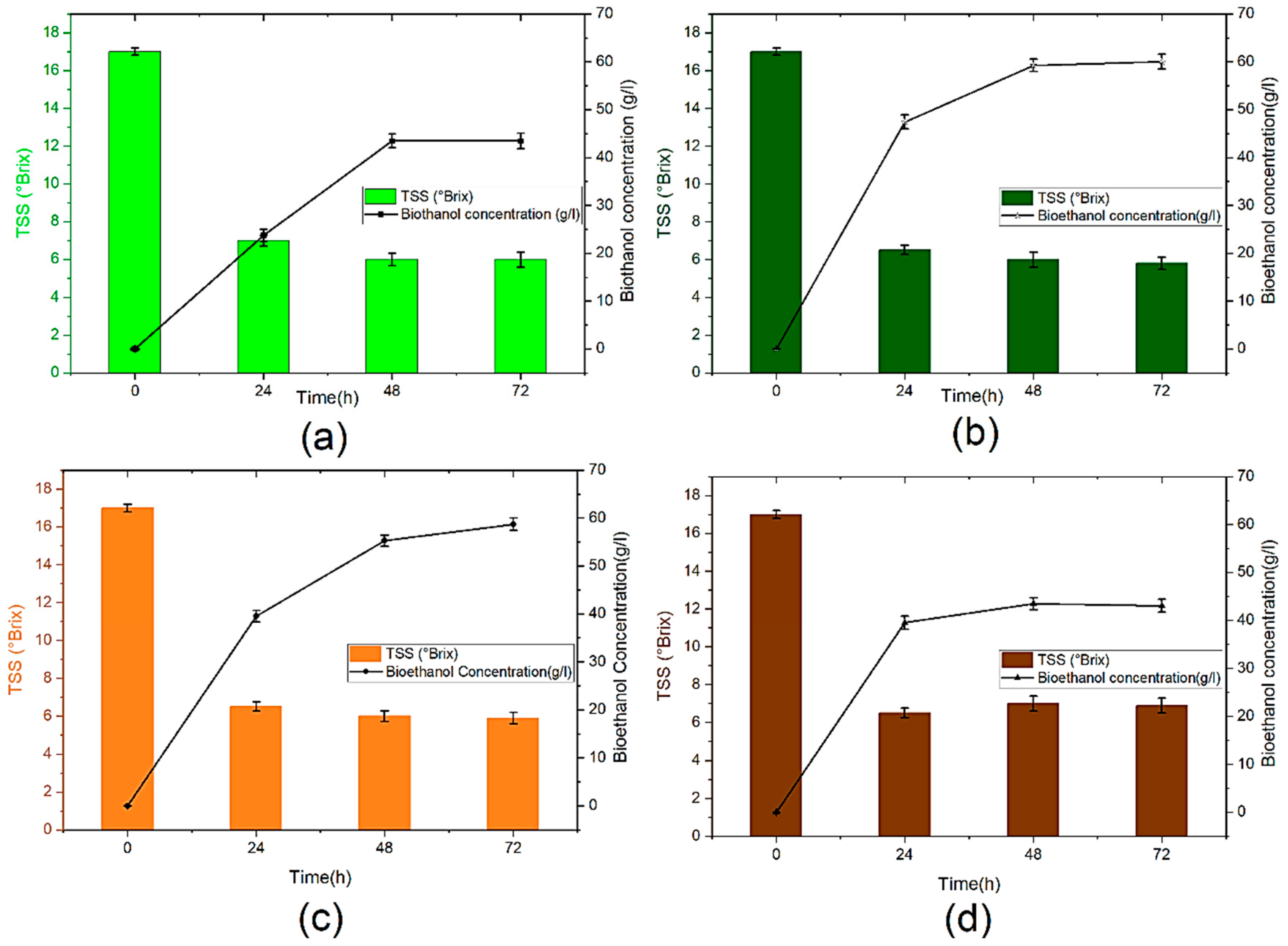
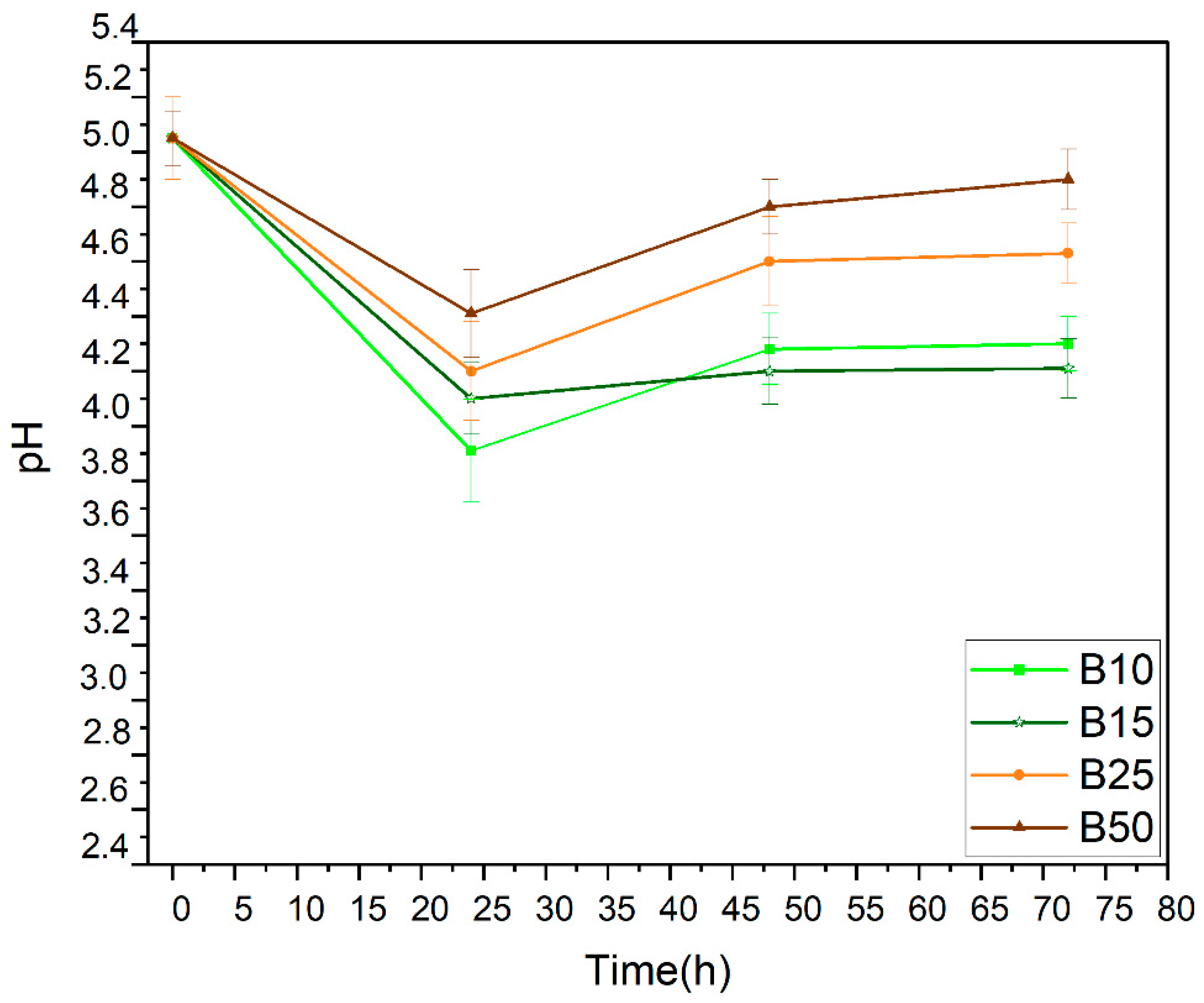
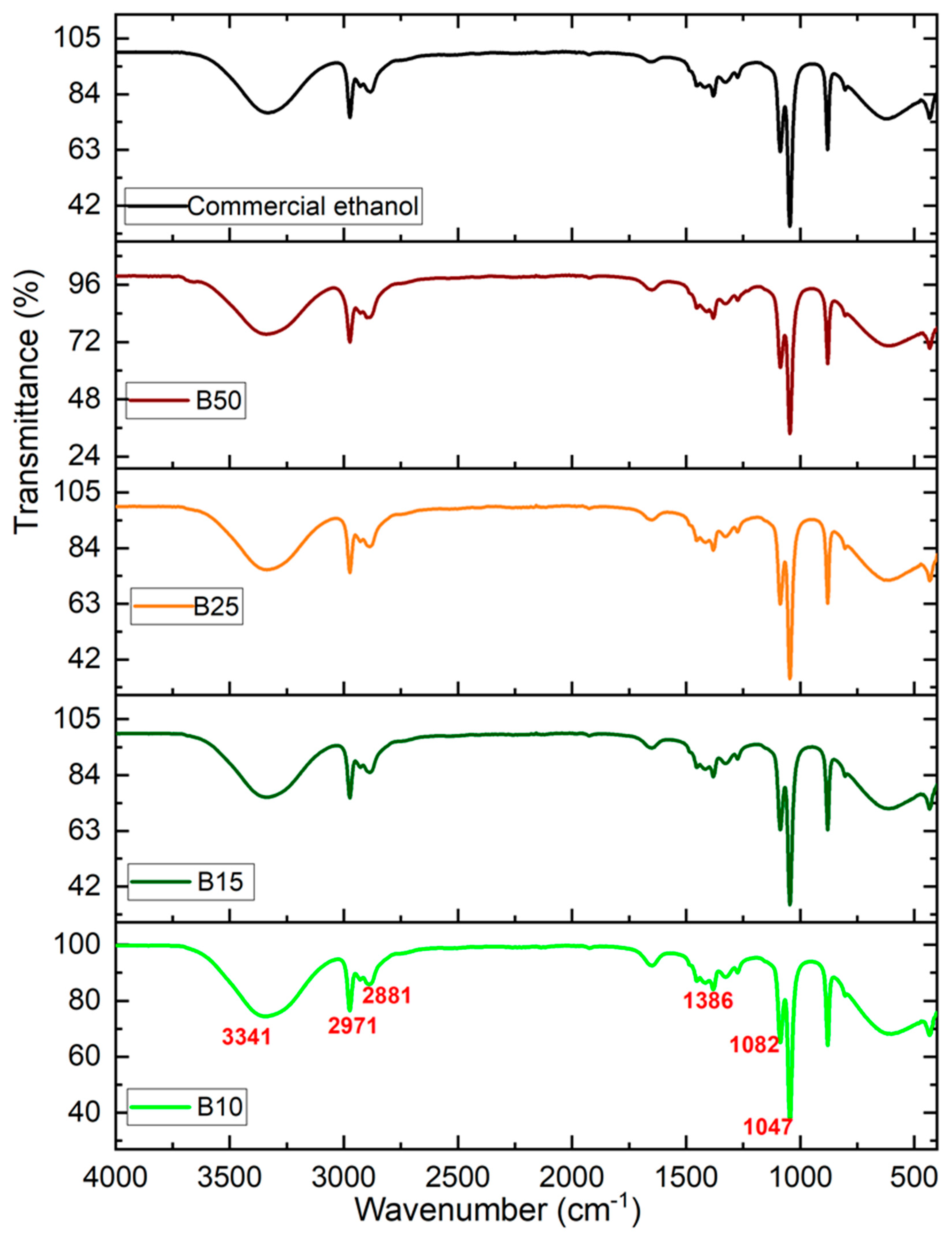


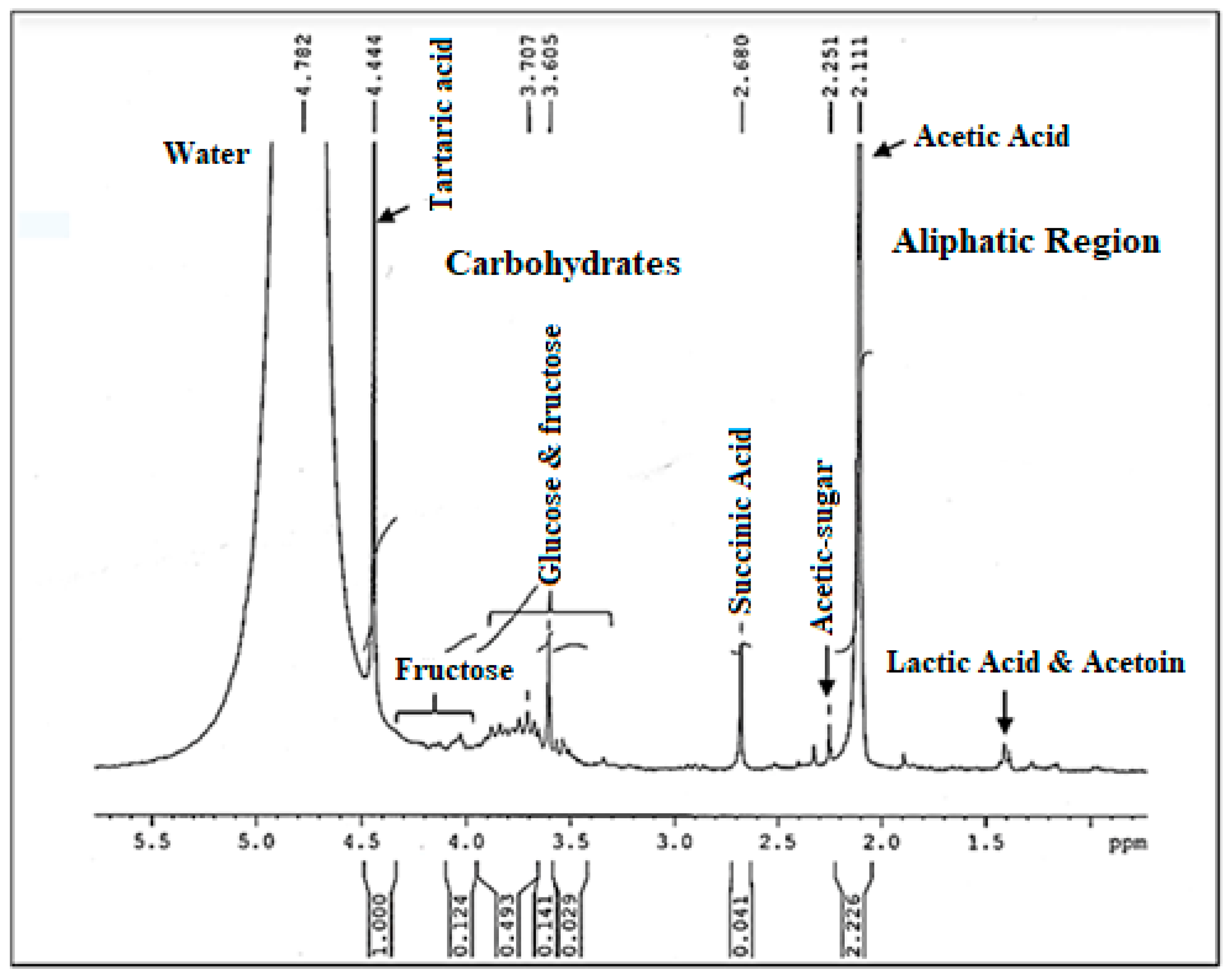
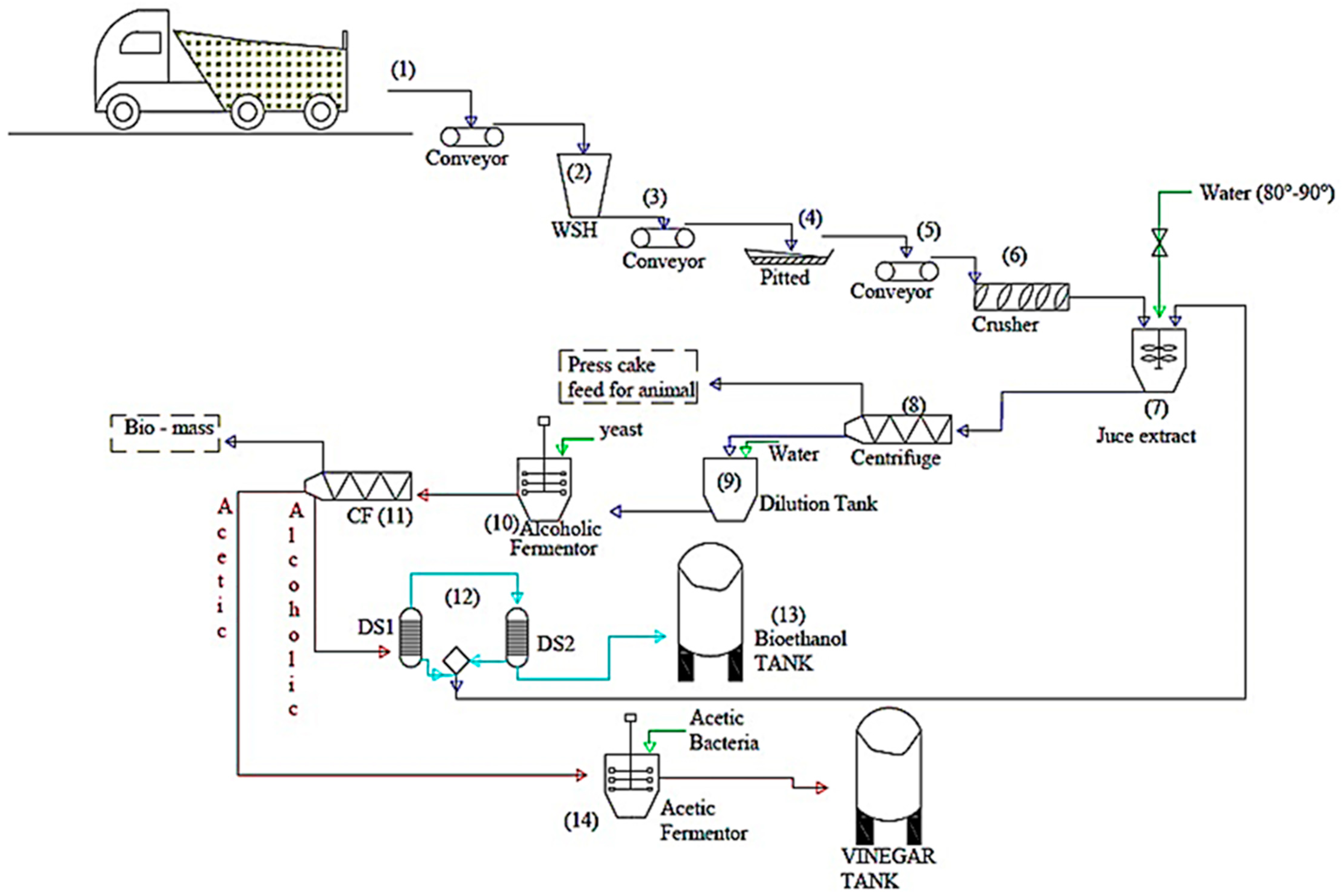
| Code | B10 | B15 | B25 | B50 | V15 |
|---|---|---|---|---|---|
| Samples | Bioethanol | Bioethanol | Bioethanol | Bioethanol | Vinegar |
| Initial TSS (°Brix) | 17 ± 0.19 | 17 ± 0.19 | 17 ± 0.2 | 17 ± 0.2 | 17 ± 0.2 |
| Yeast concentration (g/L) | 10 ± 0.1 | 15 ± 0.1 | 25 ± 0.1 | 50 ± 0.1 | 15 ± 0.1 |
| Code | B10 | B15 | B25 | B50 |
|---|---|---|---|---|
| Yeasts (g/L) | 10 | 15 | 25 | 50 |
| Ethanol yield concentration (g/L) | 43.45 ± 1.09 | 60 ± 1.08 | 58.7 ± 1.02 | 43 ± 1.02 |
| Ethanol Production Conditions | |||||||
|---|---|---|---|---|---|---|---|
| Sugar Concentration (g·L−1) | Time (h) | Temp (°C) | pH | Yeast Strains | Shaker (rpm) | Ethanol Concentration (g·L−1) | References |
| 162.2 | 72 | 30 | 5 | S. cerevisiae | 200 | 60 ± 1.08 | This work |
| 200 | 72 | 30 | 6 | S. cerevisiae | 150 | 50 | [33] |
| 174 | 72 | 28 | 6 | S. cerevisiae | 382 | 63 | [10] |
| 45 | 96 | 30 | 4 | H. guilliermondii | 150 | 11 | [9] |
| 131.4 | 48 | 30 | Un-controlled | S. cerevisiae | 120 | 48.9 | [38] |
| Samples | Source | pH | °Brix | Electrical Conductivity (μS/cm) | Ethanol (°) | Acidity (%) |
|---|---|---|---|---|---|---|
| Date vinegar | Saudi Arabia | 3.6 ± 0.1 | 5 ± 0.11 | 5650 ± 0.2 | ~0.0 ± 0.05 | 4 ± 0.1 |
| Compound | Group | δ (ppm) | Multiplicity a | J (Hz) | Hydrogen No. |
|---|---|---|---|---|---|
| Acetoin | C4H3 | 1.36 | d | 7.15 | 3 |
| Lactic acid | C3H3 | 1.42 | d | 6.84 | 3 |
| Acetic acid | C2H3 | 2.1 | s | - | 3 |
| Succinic acid | C2H2 + C3H2 | 2.68 | s | - | 4 |
| Glucose & Fructose | 3CH | 3.6 | m | - | 1 |
| 3.7 | m | - | 1 | ||
| Fructose | α(C3H + C5H) + βC5H | 4.12 | m | - | 3 |
| Tartaric acid | C2H + C3H | 4.44 | s | - | 2 |
| Vinegar Sample | TPC (mg GAE/mL) | DPPH (mg TE/mL) | FRAP (μmol AEAC/mL) | TCC (mg/100 mL) |
|---|---|---|---|---|
| Commercial vinegar | 1.12 ± 0.11 a | 0.62 ± 0.05 b | 0.58 ± 0.08 a | 0.88 ± 0.04 a |
| Deglet Nour (Tunisia) | 2.3 ± 0.15 c | 1.18 ± 0.09 c | 1.62 ± 0.12 b | 3.43 ± 0.11 b |
| Black dates (china) | 1.67 ± 0.13 b | 0.99 ± 0.02 a | 1.27 ± 0.15 c | 3.12 ± 0.15 c |
| Khalas dates (current study) | 5.81 ± 0.14 bc | 2.01 ± 0.03 a | 1.89 ± 0.11 b | 3.87 ± 0.12 b |
Publisher’s Note: MDPI stays neutral with regard to jurisdictional claims in published maps and institutional affiliations. |
© 2022 by the authors. Licensee MDPI, Basel, Switzerland. This article is an open access article distributed under the terms and conditions of the Creative Commons Attribution (CC BY) license (https://creativecommons.org/licenses/by/4.0/).
Share and Cite
Hamden, Z.; El-Ghoul, Y.; Alminderej, F.M.; Saleh, S.M.; Majdoub, H. High-Quality Bioethanol and Vinegar Production from Saudi Arabia Dates: Characterization and Evaluation of Their Value and Antioxidant Efficiency. Antioxidants 2022, 11, 1155. https://doi.org/10.3390/antiox11061155
Hamden Z, El-Ghoul Y, Alminderej FM, Saleh SM, Majdoub H. High-Quality Bioethanol and Vinegar Production from Saudi Arabia Dates: Characterization and Evaluation of Their Value and Antioxidant Efficiency. Antioxidants. 2022; 11(6):1155. https://doi.org/10.3390/antiox11061155
Chicago/Turabian StyleHamden, Zeineb, Yassine El-Ghoul, Fahad M. Alminderej, Sayed M. Saleh, and Hatem Majdoub. 2022. "High-Quality Bioethanol and Vinegar Production from Saudi Arabia Dates: Characterization and Evaluation of Their Value and Antioxidant Efficiency" Antioxidants 11, no. 6: 1155. https://doi.org/10.3390/antiox11061155







